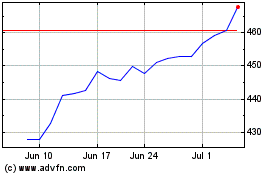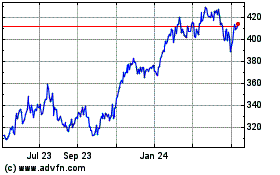Xbox One S Hits Stores Aug. 2, But Another Xbox Is On the Way
July 18 2016 - 7:11PM
Dow Jones News
By Nathan Olivarez-Giles
Microsoft Corp.'s next Xbox, the Xbox One S, lands in stores on
Aug. 2. But while the new videogame console is a smaller and more
powerful than the original Xbox One, gamers should consider a few
things before opting into an upgrade that will set them back
$399.
What's new
The Xbox One S is 40% smaller than the original Xbox One, so it
is far less of a clunker. Even better, its power supply is built
in, invisible instead of hanging out and taking up space like the
first Xbox One's. And the Xbox One S can stand vertically -- this
was a hallmark of older Xboxes, but something the first Xbox One
couldn't do.
While the Xbox One S has a faster processor, the biggest
under-the-hood difference is 4K video. Thanks to some added
processing power, the Xbox One S will stream 4K video from services
like Netflix and Amazon Video. The Xbox One S will also play the
new Ultra HD Blu-ray discs. And it will upscale 1080p games to
4K.
The Xbox One S will also support videos with a feature called
High Dynamic Range (HDR), a feature of high-end televisions that
can display a wider range of colors to create more detailed and
realistic images.
Both the 4K and the HDR will only benefit people who have
compatible TVs. If you are one of the vast majority of people whose
flat-panel TV has 1080p (aka "full HD") resolution, you won't see
any difference.
Otherwise, the Xbox One S is the same console as the original
Xbox One. Both systems will play the same games, run the same apps
for streaming music and video, and offer a very similar user
experience overall. Both will get Cortana, Microsoft's
voice-controlled assistant, in a software update next month.
The Xbox One S launch edition is available for preorder now, and
will be in stores Aug. 2 for $399 with a 2-terabyte hard drive. A
1TB version of the Xbox One S for $349 and a 500GB version for $299
will go on sale in the next few months as well.
But before you preorder, bear in mind that the Xbox One S isn't
the only new Xbox Microsoft has in the works.
Another Xbox is coming
If you are in the market for any Xbox One and you want it this
year, buy an Xbox One S. But the Xbox One S is a stopgap console.
Microsoft has said it plans to release another new Xbox next year
that "will be the most powerful console ever built."
The new console -- dubbed Project Scorpio for now -- will
support 4K and HDR video and gaming, like the Xbox One S. But it
will also support virtual-reality gaming, though Microsoft hasn't
yet said which VR headsets will be compatible. (Microsoft has a
working relationship with Oculus, and both companies compete with
Sony Corp. and its soon-to-launch VR headset, but that doesn't
automatically mean that the Oculus Rift headset would run on
Scorpio.)
So for some people, there is a bit of a decision ahead: If you
already own an Xbox One, moving to the One S may not make sense
unless you really want a slimmer model and don't care about being
first when the Scorpio surfaces.
However, Microsoft needed to hit the market with fresh hardware,
because the original Xbox One console lags behind Sony's
PlayStation 4, both in technology and in sales.
In May, Sony said it has sold more than 40 million PlayStation 4
consoles. Microsoft stopped reporting its Xbox console sales in
fall 2014, but the last reported figure was more than 10 million
units. Analysts estimate that Microsoft has sold a total of about
20 million Xbox One consoles by now.
While Microsoft uses the Xbox One S and Project Scorpio to
create Xbox buzz, Sony is taking a similar tactic, promising a new
PlayStation console that will support both 4K and VR. There is no
word when it will go on sale, however, nor how much it will cost
when it does.
Write to Nathan Olivarez-Giles at
Nathan.Olivarez-giles@wsj.com
(END) Dow Jones Newswires
July 18, 2016 18:56 ET (22:56 GMT)
Copyright (c) 2016 Dow Jones & Company, Inc.
Microsoft (NASDAQ:MSFT)
Historical Stock Chart
From Mar 2024 to Apr 2024

Microsoft (NASDAQ:MSFT)
Historical Stock Chart
From Apr 2023 to Apr 2024
